+ Open data
Open data
- Basic information
Basic information
| Entry | Database: PDB / ID: 2hdm | ||||||
|---|---|---|---|---|---|---|---|
| Title | Solution structure of V21C/V59C Lymphotactin/XCL1 | ||||||
 Components Components | Lymphotactin | ||||||
 Keywords Keywords | CYTOKINE / Lymphotactin / XCL1 / chemokine / conformational restriction | ||||||
| Function / homology |  Function and homology information Function and homology informationmature natural killer cell chemotaxis / positive regulation of granzyme A production / negative regulation of T-helper 1 cell activation / positive regulation of immunoglobulin production in mucosal tissue / positive regulation of granzyme B production / positive regulation of thymocyte migration / positive regulation of B cell chemotaxis / negative regulation of T-helper 1 type immune response / negative regulation of T cell cytokine production / positive regulation of transforming growth factor beta production ...mature natural killer cell chemotaxis / positive regulation of granzyme A production / negative regulation of T-helper 1 cell activation / positive regulation of immunoglobulin production in mucosal tissue / positive regulation of granzyme B production / positive regulation of thymocyte migration / positive regulation of B cell chemotaxis / negative regulation of T-helper 1 type immune response / negative regulation of T cell cytokine production / positive regulation of transforming growth factor beta production / positive regulation of natural killer cell chemotaxis / chemokine receptor binding / positive regulation of T cell chemotaxis / positive regulation of T-helper 1 cell cytokine production / CCR chemokine receptor binding / positive regulation of T-helper 2 cell cytokine production / positive regulation of leukocyte chemotaxis / negative regulation of CD4-positive, alpha-beta T cell proliferation / positive regulation of CD4-positive, alpha-beta T cell proliferation / chemokine-mediated signaling pathway / chemokine activity / positive regulation of neutrophil chemotaxis / Chemokine receptors bind chemokines / positive regulation of CD8-positive, alpha-beta T cell proliferation / negative regulation of interleukin-2 production / negative regulation of type II interferon production / positive regulation of interleukin-10 production / cellular response to transforming growth factor beta stimulus / release of sequestered calcium ion into cytosol / neutrophil chemotaxis / cellular response to interleukin-4 / positive regulation of release of sequestered calcium ion into cytosol / cell chemotaxis / positive regulation of T cell cytokine production / positive regulation of T cell mediated cytotoxicity / response to virus / antimicrobial humoral immune response mediated by antimicrobial peptide / cell-cell signaling / regulation of inflammatory response / G alpha (q) signalling events / positive regulation of cell migration / inflammatory response / negative regulation of DNA-templated transcription / signal transduction / protein homodimerization activity / positive regulation of transcription by RNA polymerase II / extracellular space / extracellular region Similarity search - Function | ||||||
| Biological species |  Homo sapiens (human) Homo sapiens (human) | ||||||
| Method | SOLUTION NMR / AUTOMATED METHODS WERE USED FOR BACKBONE CHEMICAL SHIFT ASSIGNMENT, ITERATIVE NOE REFINEMENT. | ||||||
 Authors Authors | Volkman, B.F. / Tuinstra, R.L. / Peterson, F.C. / Elgin, E.S. | ||||||
 Citation Citation |  Journal: Biochemistry / Year: 2007 Journal: Biochemistry / Year: 2007Title: An engineered second disulfide bond restricts lymphotactin/XCL1 to a chemokine-like conformation with XCR1 agonist activity Authors: Tuinstra, R.L. / Peterson, F.C. / Elgin, E.S. / Pelzek, A.J. / Volkman, B.F. | ||||||
| History |
|
- Structure visualization
Structure visualization
| Structure viewer | Molecule:  Molmil Molmil Jmol/JSmol Jmol/JSmol |
|---|
- Downloads & links
Downloads & links
- Download
Download
| PDBx/mmCIF format |  2hdm.cif.gz 2hdm.cif.gz | 517 KB | Display |  PDBx/mmCIF format PDBx/mmCIF format |
|---|---|---|---|---|
| PDB format |  pdb2hdm.ent.gz pdb2hdm.ent.gz | 436.3 KB | Display |  PDB format PDB format |
| PDBx/mmJSON format |  2hdm.json.gz 2hdm.json.gz | Tree view |  PDBx/mmJSON format PDBx/mmJSON format | |
| Others |  Other downloads Other downloads |
-Validation report
| Summary document |  2hdm_validation.pdf.gz 2hdm_validation.pdf.gz | 358.8 KB | Display |  wwPDB validaton report wwPDB validaton report |
|---|---|---|---|---|
| Full document |  2hdm_full_validation.pdf.gz 2hdm_full_validation.pdf.gz | 488.2 KB | Display | |
| Data in XML |  2hdm_validation.xml.gz 2hdm_validation.xml.gz | 22.7 KB | Display | |
| Data in CIF |  2hdm_validation.cif.gz 2hdm_validation.cif.gz | 40 KB | Display | |
| Arichive directory |  https://data.pdbj.org/pub/pdb/validation_reports/hd/2hdm https://data.pdbj.org/pub/pdb/validation_reports/hd/2hdm ftp://data.pdbj.org/pub/pdb/validation_reports/hd/2hdm ftp://data.pdbj.org/pub/pdb/validation_reports/hd/2hdm | HTTPS FTP |
-Related structure data
| Similar structure data |
|---|
- Links
Links
- Assembly
Assembly
| Deposited unit | 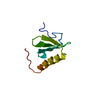
| |||||||||
|---|---|---|---|---|---|---|---|---|---|---|
| 1 |
| |||||||||
| NMR ensembles |
|
- Components
Components
| #1: Protein | Mass: 10195.685 Da / Num. of mol.: 1 / Mutation: V21C, V59C Source method: isolated from a genetically manipulated source Source: (gene. exp.)  Homo sapiens (human) / Gene: XCL1, LTN, SCYC1 / Plasmid: pQE308HT / Production host: Homo sapiens (human) / Gene: XCL1, LTN, SCYC1 / Plasmid: pQE308HT / Production host:  |
|---|---|
| Has protein modification | Y |
-Experimental details
-Experiment
| Experiment | Method: SOLUTION NMR | ||||||||||||||||
|---|---|---|---|---|---|---|---|---|---|---|---|---|---|---|---|---|---|
| NMR experiment |
| ||||||||||||||||
| NMR details | Text: ALL TRIPLE-RESONANCE AND NOESY SPECTRA WERE ACQUIRED USING A CRYOGENIC PROBE |
- Sample preparation
Sample preparation
| Details | Contents: 1 mM CC3 hLtn, U-15N, 13C; 20 mM phospate buffer, 90% H2O, 10% D2O Solvent system: 90% H2O/10% D2O |
|---|---|
| Sample conditions | Ionic strength: 10 mM / pH: 6 / Pressure: AMBIENT / Temperature: 298 K |
-NMR measurement
| Radiation | Protocol: SINGLE WAVELENGTH / Monochromatic (M) / Laue (L): M |
|---|---|
| Radiation wavelength | Relative weight: 1 |
| NMR spectrometer | Type: Bruker DRX / Manufacturer: Bruker / Model: DRX / Field strength: 600 MHz |
- Processing
Processing
| NMR software |
| ||||||||||||||||||||||||||||
|---|---|---|---|---|---|---|---|---|---|---|---|---|---|---|---|---|---|---|---|---|---|---|---|---|---|---|---|---|---|
| Refinement | Method: AUTOMATED METHODS WERE USED FOR BACKBONE CHEMICAL SHIFT ASSIGNMENT, ITERATIVE NOE REFINEMENT. Software ordinal: 1 Details: STRUCTURES ARE BASED ON A TOTAL OF 1234 NOE CONSTRAINTS ( 418 INTRA, 333 SEQUENTIAL, 153 MEDIUM and 330 LONG RANGE CONSTRAINTS) AND 82 PHI AND PSI DIHEDRAL ANGLE CONSTRAINTS. | ||||||||||||||||||||||||||||
| NMR representative | Selection criteria: lowest energy | ||||||||||||||||||||||||||||
| NMR ensemble | Conformer selection criteria: target function / Conformers calculated total number: 100 / Conformers submitted total number: 20 |
 Movie
Movie Controller
Controller




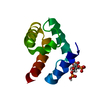
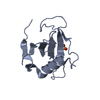
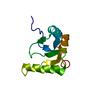

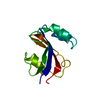
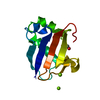


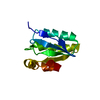
 PDBj
PDBj
 NMRPipe
NMRPipe